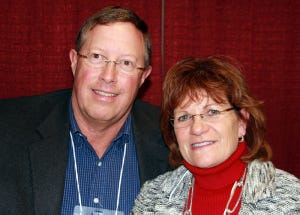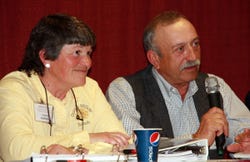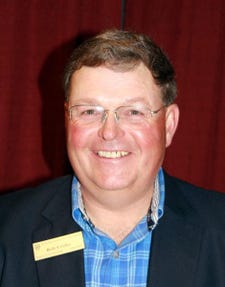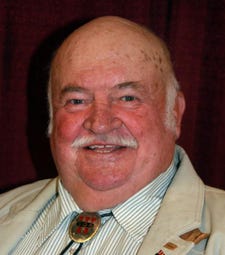Ranch Families Share Their Estate Transfer Experiences
Farm transfer from one generation to the next is a lengthy and sensitive endeavor in the best of circumstances. Too often, tales of losing the operation, or permanent family rifts, are the result. Ranching families share their lessons learned in transferring operations within the family.
March 28, 2012

Farm transfer from one generation to the next is a lengthy and sensitive endeavor in the best of circumstances. Too often, tales of losing the operation, or permanent family rifts, are the result.
Recently, the Wyoming Stock Growers Association (WSGA) conducted a producer panel discussion as part of a session on agriculture succession and estate transfer. Here are some thoughts on the process from members of the “older” generation. All operate in Wyoming.
Frank and Elaine Moore
The Moore family has ranched north of Douglas for a century. Two sons currently run the 58,000-acre ranch in two separate units, but work together on the operation. The family summers 4,000-6,000 head of yearlings, owns about 2,000 sheep, and 150-200 mother cows. Patriarch Frank Moore has lived on the ranch his entire life, and his boys are the fourth generation to run the ranch.
 “With much discussion, much give and take, and more discussion, we split the ranch into two reasonably equal units for two sons who wanted to return to the operation,” Frank says. “This was probably the hardest part of the transition to the next generation. You find there are different attachments for different things and everybody has their own opinion.
“With much discussion, much give and take, and more discussion, we split the ranch into two reasonably equal units for two sons who wanted to return to the operation,” Frank says. “This was probably the hardest part of the transition to the next generation. You find there are different attachments for different things and everybody has their own opinion.
“We’d talk about different options of how to split it, and what everybody wanted. Then, we’d give everyone a couple of weeks to process the information. Then we’d meet and share our thoughts.
“The two sons bought the livestock and equipment from us to start their operations, and are buying out their third brother, who didn’t return to the ranch. They run as two separate ranches, but we help each other with various jobs throughout the year.
“This arrangement isn’t as efficient as running the ranch as one unit, but it gives them each the responsibility, freedom and ownership to run their own operation. Best of all, it maintains a really good working relationship between brothers.
“The most important thing when planning for the future is to be flexible, trust your kids, and give them a chance to make their own way. Let go of the reins and get out of the way – they’ll do fine. Get together with a good estate planner to start the process. Estate laws are as favorable as they’re going to get right now, and it may not last,” he says.
Frank Shepperson
The Shepperson family came to the Midwest, WY, locale via the Chisolm Trail in the mid 1800s, and have ranched there since. They run a cow-calf operation, and have sold to the same buyer, either private treaty or on the video, for over 20 years. All family members have part ownership, brand their own heifer calves, and receive a percentage of the steer calves in the fall.
 “I believe in trust, communication and guidance early in life. It takes a team to keep a sustainable operation going, and that can be your family and/or employees. That team needs to celebrate its successes, and young people need to be encouraged to follow the fire in their heart,” Shepperson says.
“I believe in trust, communication and guidance early in life. It takes a team to keep a sustainable operation going, and that can be your family and/or employees. That team needs to celebrate its successes, and young people need to be encouraged to follow the fire in their heart,” Shepperson says.
“In lots of these families, kids go to college. Before they go off to college, let them know the wonderful things that happen in ranching. Let them see the ecology and the things that go on at the ranch, and let them learn to enjoy those things.
“Then, after they go off to college, we make our kids get a job before they come back; to make sure they have that fire for ranching,” he says.
Paul and Catherine Kukowski
The Kukowskis operate a Saler-based cow-calf and yearling operation headquartered southeast of Sheridan, on 20,000 deeded and leased acres in Wyoming and Montana. Yearlings are sold off grass in August, either on video or through their daughter, who buys for an order buyer. Both Paul and Catherine’s families have ranched for at least three generations; the couple moved from North Dakota to Wyoming in 1991.
“We operate with all of our real estate in an S corporation, and we each own 50%, and all our assets are owned 50/50,” Paul says. “All five of our kids were raised very independently, and they all left. They’re all in agriculture, and run the gamut within the industry, and we’re here alone running these cattle.
“Our thought process is to pass on a sustainable business, rather than ownership of the land. We’ve had the discussion with our children that each could receive a 20% share of the ranch.
 “We posed the question this way: ‘Fast-forward 30 years, and say one of your daughters is running the ranch, and she has siblings. So, she’s sitting there, trying to run the ranch, but with maybe 20% control of 20%. How does that sound to you?’ They all thought maybe that wasn’t the best option long-term.
“We posed the question this way: ‘Fast-forward 30 years, and say one of your daughters is running the ranch, and she has siblings. So, she’s sitting there, trying to run the ranch, but with maybe 20% control of 20%. How does that sound to you?’ They all thought maybe that wasn’t the best option long-term.
“So, at this point, we’re looking at creating a trust and, as they’re all individuals, they can build their own estates; that’s what we want them to do. We believe the real estate needs to be separate, and whoever is running the ranch needs to own the cattle and equipment. Then, they can buy land, and what we pass on becomes a steppingstone up. I like to think it will work for future generations,” Paul says.
Rob Croft
The Crofts have ranched in Fremont County since the 1860s, and own a relatively small amount of acreage, which is supplemented with leased land. They run a cow-calf and yearling operation in Lander, and have sold their Angus and Hereford-bred cattle private treaty to the same man almost exclusively for two decades.
 “My advice would be that you can’t do an estate transfer without an accountant, and you need a lawyer to guide you through the process. One thing to tell mom and dad is to think outside the box, because fair isn’t always equal, and equal isn’t always fair,” Croft says.
“My advice would be that you can’t do an estate transfer without an accountant, and you need a lawyer to guide you through the process. One thing to tell mom and dad is to think outside the box, because fair isn’t always equal, and equal isn’t always fair,” Croft says.
“Buy some life insurance, then you don’t have to take that money out when your kids are trying to run the ranch. I think it’s part of the parents’ responsibility to add income through diversification, so the children can come back and you and them aren’t both strapped financially,” he says.
Tom Wright
A total of 1,300 mother cows, 80-85% Charolais and 15-20% Gelbvieh, make up the Wright family’s cowherd near Newcastle. They raise their own replacements, and have finished most of their cattle for 20 years. Four families, plus some hired help, live on the ranch, which totals around 100,000 deeded and leased acres.
“We ranch in an S corporation, two C corporations, an LLC, privately owned land, partner-owned cattle, privately owned cattle, and then we’re involved in a couple other LLCs with other family members. In our case, we don’t have a single pasture that you can buy from one entity. One problem out there is that we’re all members of the company, and we’re ranching together as the company, but we also want something that is just ours,” Wright says.
 “We have to remember that ranching shouldn’t be a trap. It’s part of our plan to make it worth money for you to cooperate. I want my kids and grandkids to be able to say, ‘Gosh, there are some annoying things about my brother-in-law, but it’s worth real money to me to get along.’ Part of the reason we have a nice-sized outfit is because the family has been able to get along,” Wright says.
“We have to remember that ranching shouldn’t be a trap. It’s part of our plan to make it worth money for you to cooperate. I want my kids and grandkids to be able to say, ‘Gosh, there are some annoying things about my brother-in-law, but it’s worth real money to me to get along.’ Part of the reason we have a nice-sized outfit is because the family has been able to get along,” Wright says.
You May Also Like



